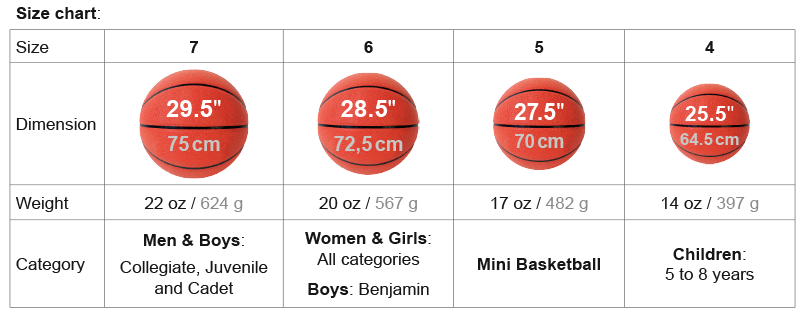-
Sports
- Archery
- Badminton
- Baseball & Softball
- Basketball
- Boxing
- Broomball
- DBL Ball
- Floorball
- FooBaSKILL
- Football
- Frisbee
- Futsal
- Golf
- Gymnastics & Cheerleading
- Handball
- Hockey
- Kin-Ball® - OMNIKIN®
- Lacrosse
- Pickleball
- Ringette
- Rugby
- Soccer
- Table Tennis
- Tchoukball
- Tennis
- Track & Field
- Volleyball
- Water Polo
- You.Fo®
-
Equipment
- Various Accessories
- Carts, Bags & Storage
- Timers & Stopwatches
- Cones & Markers
- Scrimmage Vests & Pinnies
- Outdoor Equipment
- Gymnasium Equipment
- Measurement & Marking Equipment
- Eye Guards
- Mats & Accessories
- Pumps & Needles
- Whistles & Accessories
- Scoreboards
- Therapy & First Aid
- Game Boards
- I.T.C.A. Equipment
-
Activities
- Early Years
-
Municipality/Park
- High Performance
- Sports-Inter - Distributor of Sports & Recreational Equipment
- >Basketball - Size and material guide
Choosing the right basketball
The size is the first criterion that should guide your choice. Indeed, each ball has a specific weight and circumference. This is why it is important to take into account the age of the players, as well as their level of practice.

Basketballs can be made of various materials: leather (composite, synthetic), rubber or plastic. Each one is adapted to a specific practice, indoors or outdoors.
For indoor | For outdoor | For indoor | ||
For an indoor basketball, it is the quality of the rebounds that matters. As the game is played on a gym floor, the ball can be used longer.
Investing in a leather model remains the best solution to optimize its performance. |
An outdoor basketball must offer a higher resistance because the grounds are often laid out with consolidated gravel or bitumen.
We recommend a rubber ball that is more resistant to abrasive materials, while allowing you to obtain quality rebounds to enjoy optimal playing comfort. | If practices take your team to the gym and outdoors, choose a synthetic leather ball.
This one offers a certain resistance to bitumen and high quality rebounds on parquet, as on asphalt. |
